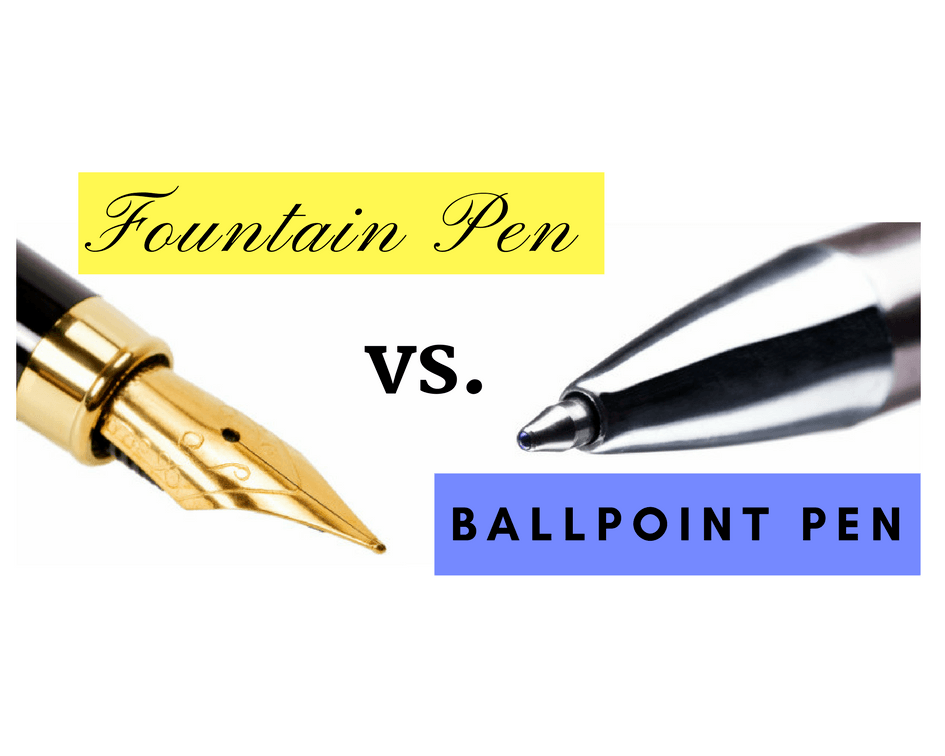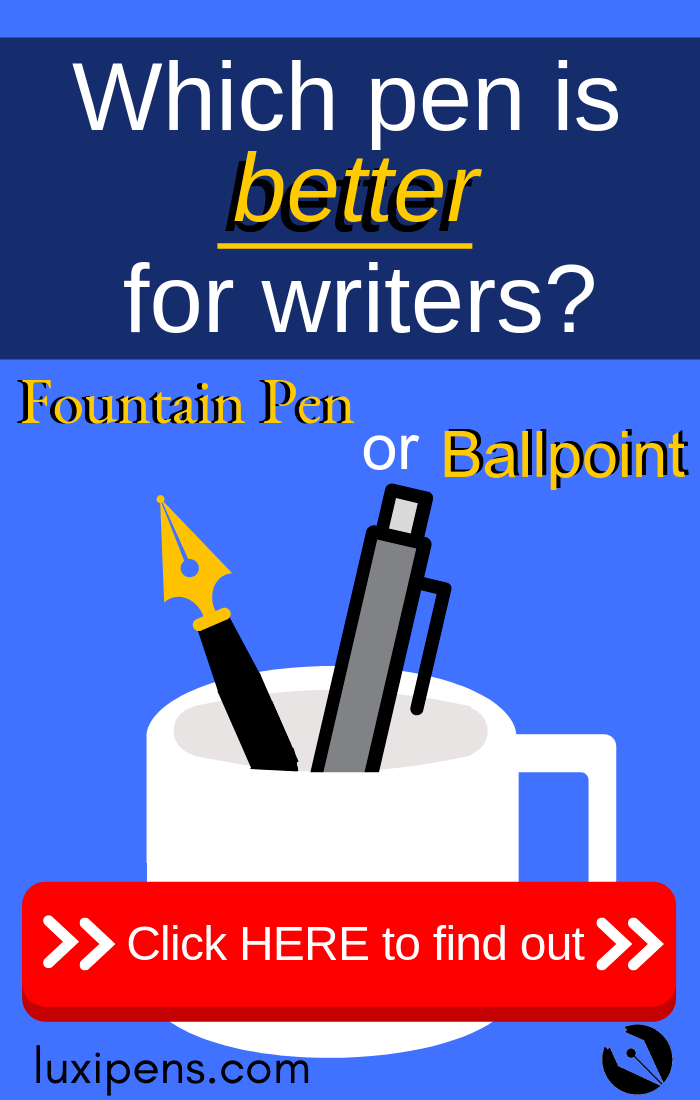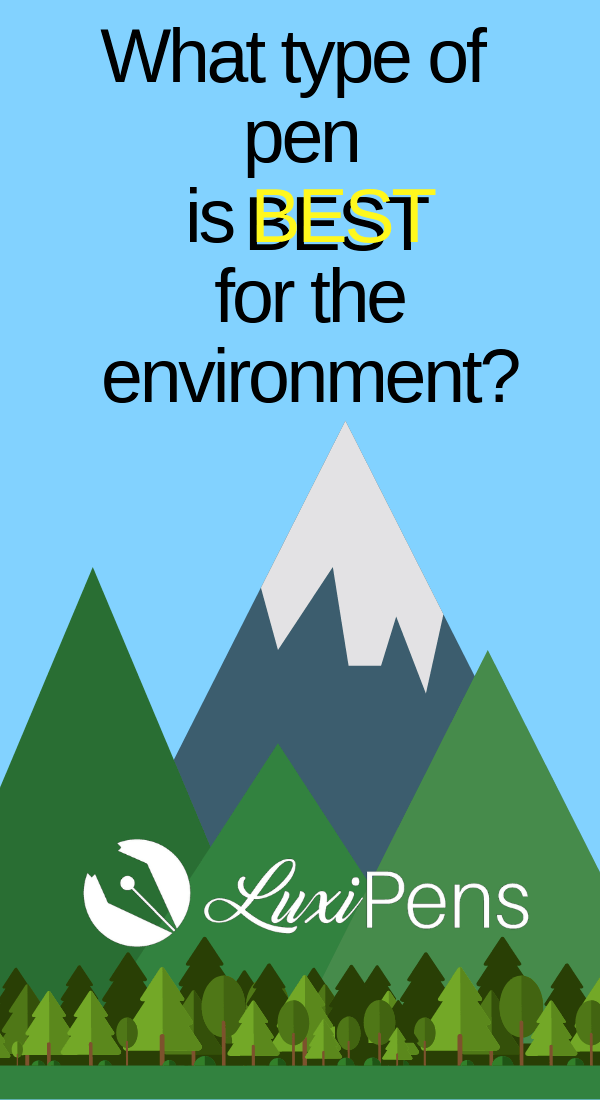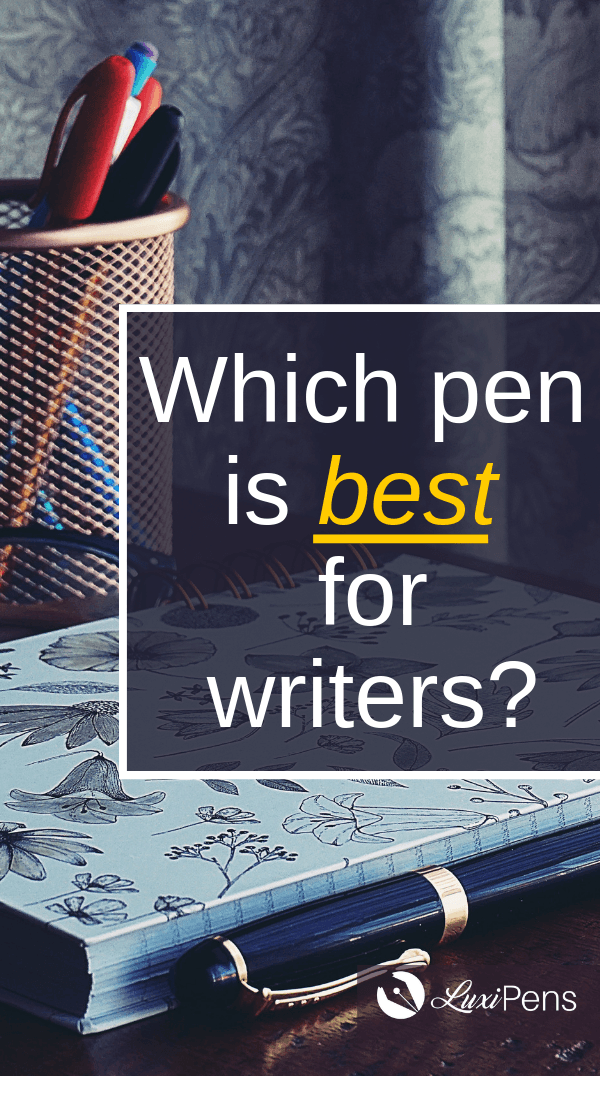Fountain pen vs Ballpoint: It's time to end the debate
No matter why you use it, a good pen can be a useful tool in your personal and professional life. There are so many pens available on the market today that it can be difficult to choose a specific one. The chief argument between writers today is whether or not to use a Fountain pen vs Ballpoint.
While ballpoint pens are more convenient and readily available, fountain pens are more environmentally friendly and considered to be more comfortable to write with than ballpoints.
This article will highlight the benefits and disadvantages of both fountain pens and ballpoint pens. Familiarizing yourself with the fundamental differences between the two forms of writing utensils, as well as understanding your personal writing style, can help you select the pen that works best for you.
Types of Pens
*Notice: Mobile devices - scroll right to see entire table.
Type of Pen | Type of Ink | How it Works |
|---|---|---|
Fountain Pen | Water-Based | Ink flows from an internal reservoir down to the nib |
Ballpoint Pen | Oil-Based | Ink flows from narrow plastic tube and coats a metal ball bearing located at the tip |
Gel Pen | Gel Ink | Uses gel ink, which is a combination of permanent oil-based ink and smooth writing of water-based ink |
Rollerball Pen | Water or Gel-Based | A ballpoint pen designed to use water or gel-based ink |
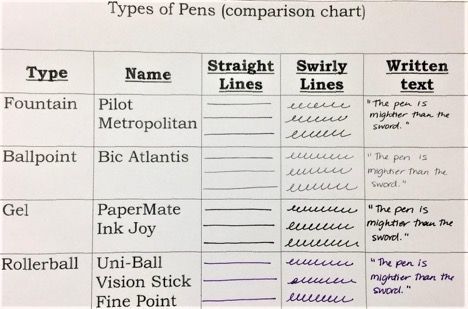
A comparison of the written lines using one brand and model for each type of pen. The chart compares straight lines, swirly lines, and written text. (chart and photograph courtesy of the author)
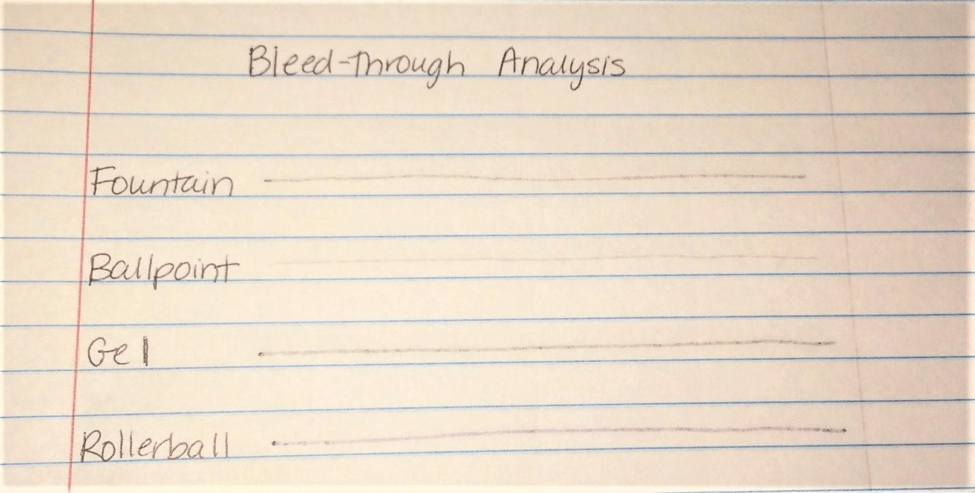
A bleed-through analysis using an example of the types of pens used in the above chart. Pens with water-based ink are more likely to bleed through the page. The type of paper used also will influence these results. The paper used in this photograph is composition book paper. (photograph courtesy of the author)
Fountain Pen vs. Ballpoint
Price Difference
The prices of fountain pens range based on sophistication: the basic models start at about $20, and more advanced models cost hundreds of dollars.
Ballpoint pens are considerably cheaper, with a price point around only a few dollars for a small set of pens.
Cost over Time
Fountain pens require replacing the ink reservoir or refilling it with bottled ink. Some ballpoint pen manufacturers produce extra ink refills for their pens. Most consumers are unaware of their availability and throw away the entire unit away when the ink runs out. Over time, a well-maintained fountain pen will be much less expensive than replacing ballpoint pens.
Environmental Impact
Fountain pens are more environmentally friendly than ballpoint pens. Fountain pen ink cartridges are disposable, but consumers can refill them with bottled ink. Using converters also produces less waste, as bottled ink recharges the reservoir.
Although some manufacturers produce disposable fountain pens, these models are not as popular as the refillable models.
Physical Wear on Body
The small amount of pressure necessary to write with a fountain pen, as well as its comfortable fit in the hand, produces less stress on the fingers and hands.
Using ballpoint pens requires more pressure to write, causing hand stiffness and cramps with extended use.
Leakage
In rare cases, fountain pens can leak from structural deformities such as a cracked barrel, a broken or torn ink reservoir, or a weak connection between the nib and the ink reservoir. In some cases, if there is air trapped inside the ink reservoir, fountain pens can leak from the change in pressure during airplane travel.
On the other hand, ballpoint pens leak less than fountain pens, even while in flight.
Personal Preference
Fountain pens are experiencing a resurgence in popularity because they symbolize nostalgia for a simpler time before the technological age. They have become status symbols known for their class and elegance.
Ballpoint pens are more technologically advanced, and mass production has increased their distribution and use.
Writing
Fountain pens are more versatile than ballpoint pens because they conform to your writing style. A variety of nib sizes allow a writer to change the thickness of the lines with each stroke.
Ballpoint pens are less adaptable than fountain pens. They produce uniform strokes on the page with no variance in the marks. Unlike fountain pens, where nibs of different sizes are interchangeable, there is no ability to change the size of the metal ball at the tip of the pen. Instead, you’ll have to purchase a variety of ballpoint pens of varying sizes.
Bleeding through Paper
Some inks are more likely to bleed through paper. Paper quality affects bleed-through as much as the ink you are using. Thinner paper absorbs ink more than thicker paper. Water-based inks used in fountain pens can fade over time are less likely to adhere to other types of surfaces.
The oil-based ink used in ballpoint pens is more permanent than water-based ink. It dries quickly and is less likely to bleed through paper. Oil-based ink can write on glossy paper, like the kind found in college textbooks, while water-based inks do not.
Convenience
Fountain pens require a little extra care when traveling. Sealing them in a leakproof bag like a Ziploc Freezer Quart Bag, available here, will protect your belongings in case of leakage.
Fountain pens also need additional regular maintenance, such as refilling the ink, flushing the pen, and replacing the ink reservoir. Ballpoint pens are more suitable for travel, and they are more practical for people on-the-go.
What is a Fountain Pen?
A fountain pen is a customizable, permanent, and environmentally-friendly writing utensil that uses capillary action to manage the flow of ink from an internal ink reservoir to the nib. Compared to a ballpoint pen, the fountain pen’s denser size and heavier weight when touching the paper creates ink traces, requiring less hand pressure when writing. A variety of nib size options allows the fountain pen to adapt to the writing style of the user.
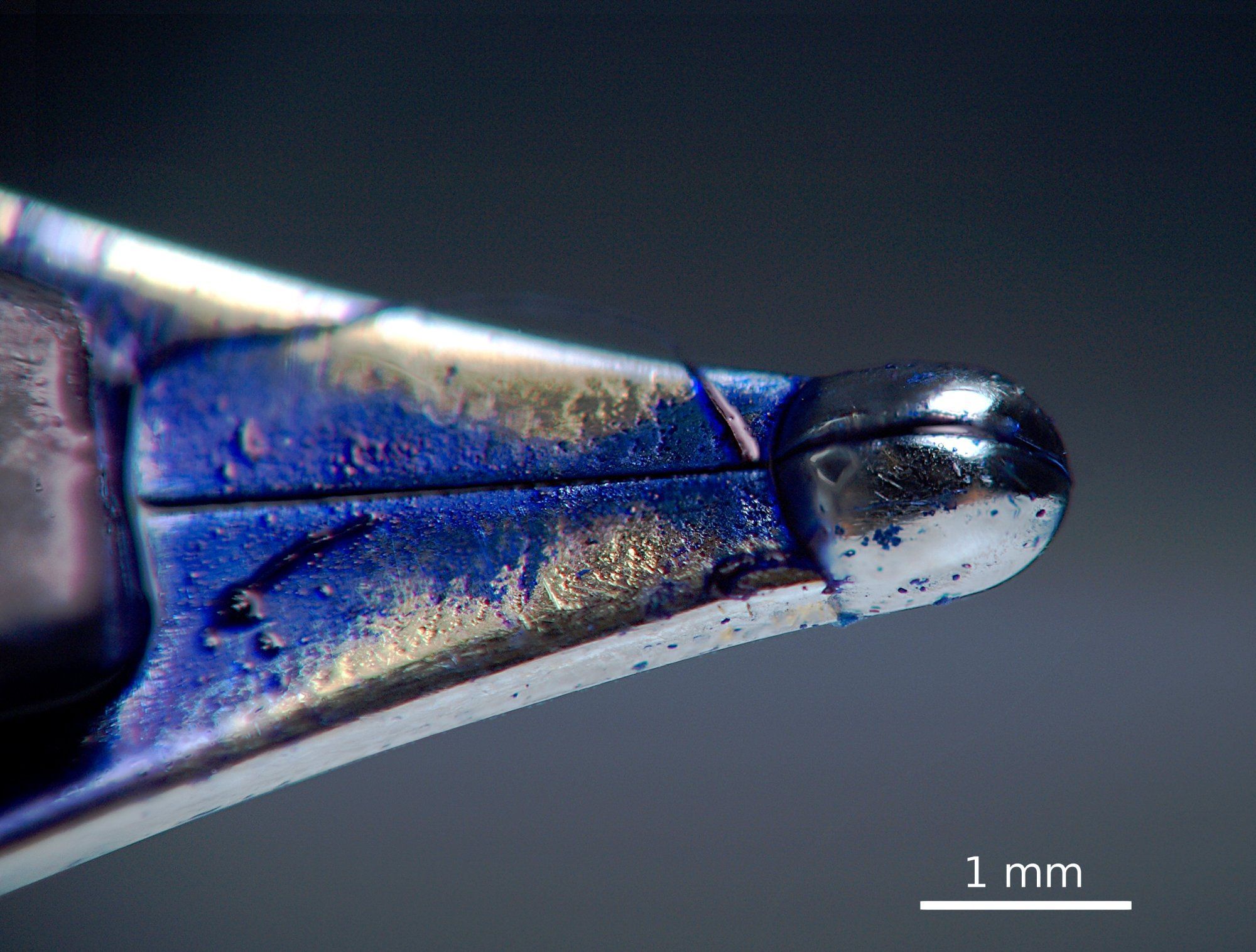
The magnified tip of a fountain pen, courtesy of Thomas Wydra
Inspired by its predecessor the quill pen, the fountain pen is considerably older than a ballpoint pen. The first documented reference to the device that inspired the modern fountain pen is from the tenth century. In 953 AD, Abu Tamim Ma’ad al-Mu’izz Li-Din Allah, the ruler of the Fatimid Caliphate, requested the invention of a new pen that would keep ink from staining his clothes and his skin.
During the Renaissance, Leonardo da Vinci recorded the first study of capillary action, which is the force that allows liquid to flow without the use of gravity. This discovery fueled the technology for fountain pens centuries later.
Although people have been using fountain pens in some form since the early 1700s, the Romanian engineer Petrache Poenaru patented the first design for the fountain pen in May 1827. By 1884, insurance salesman Lewis Waterman innovated upon Poenaru's original patent, creating an improved design which allowed a more regulated flow of the ink to the nib. Waterman then patented his new design which would then lay the foundation of his new company, the Waterman Pen Company, which is still in business today.
If you'd like to learn more about the history of fountain pens, you can review our post on "Why is a Fountain Pen Called a Fountain Pen?" and learn about how the fountain pen got its name.
When ballpoint pens went into mass production, the fountain pen dropped in popularity. However, fountain pens are experiencing a recent resurgence. Sales of fountain pens have increased over the past several years, mainly due to their association with status, even though purchases of other luxury items have dropped. Many have sought out the fountain pen as a personal accessory piece, similar to a luxury watch, because of its nostalgic tie to life before the digital age.
Fountain Pen Basics
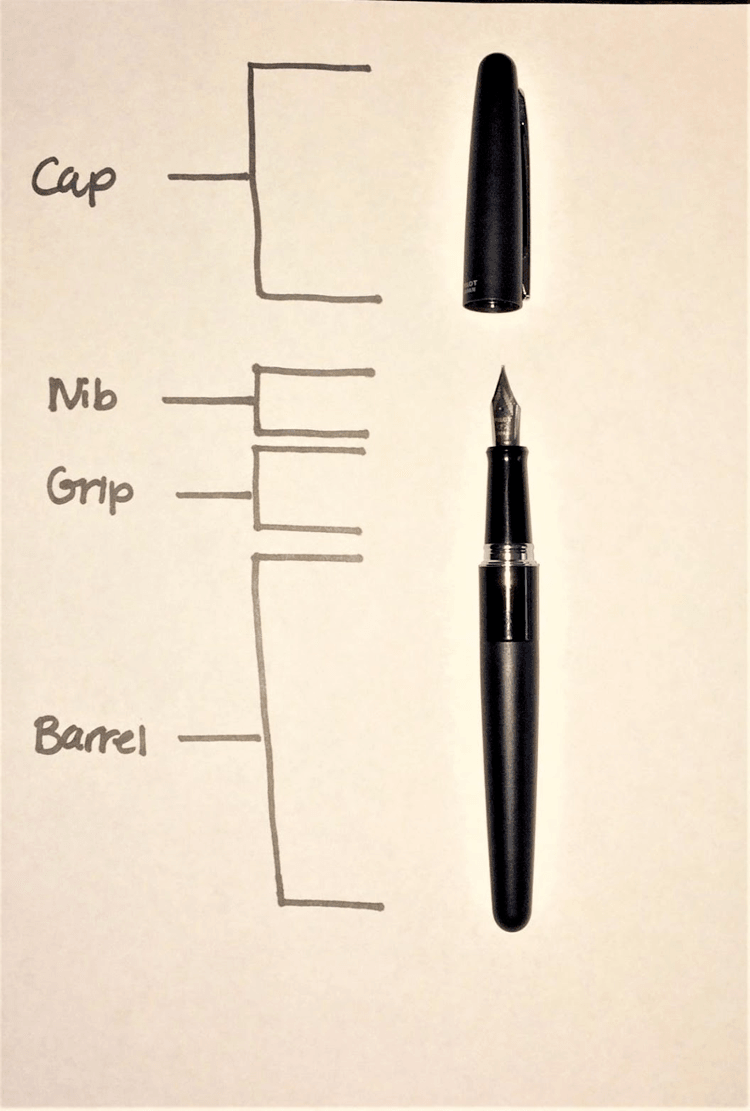
A diagram of a fountain pen. The ink reservoir is located inside the barrel. (Photograph of diagram courtesy of the author)
Liquid or water-based ink flows from an internal ink reservoir to the nib using capillary action, the ability for fluid to move into spaces without the use of, or sometimes against, gravity. Fountain pen manufacturers now distribute disposable cartridges to refill the ink reservoir. If you use your fountain pen regularly, you need to clean it about once a month.
While neither ballpoint pens nor fountain pens are seriously known to leak, the chances of a fountain pen leaking are more common than a ballpoint pen exploding. While fountain pens can be pricey, they will work for years with proper maintenance.
The best fountain pens are the ones that rest comfortably in your hand while writing. Fountain pens are ergonomically better, as they require very little pressure to write compared to a ballpoint pen where heavy pressure while writing is a requirement.
An intact and well-maintained nib controls the flow of the ink from the reservoir to the paper, allowing you to write effortlessly. Nibs come in many sizes, from super fine to broad, depending on your preference, and the nib enables you to change your writing style. Choosing the size of the nib can be intimidating, but a general rule is that those who write smaller will want a fine nib, and those who write large will want a thicker nib.
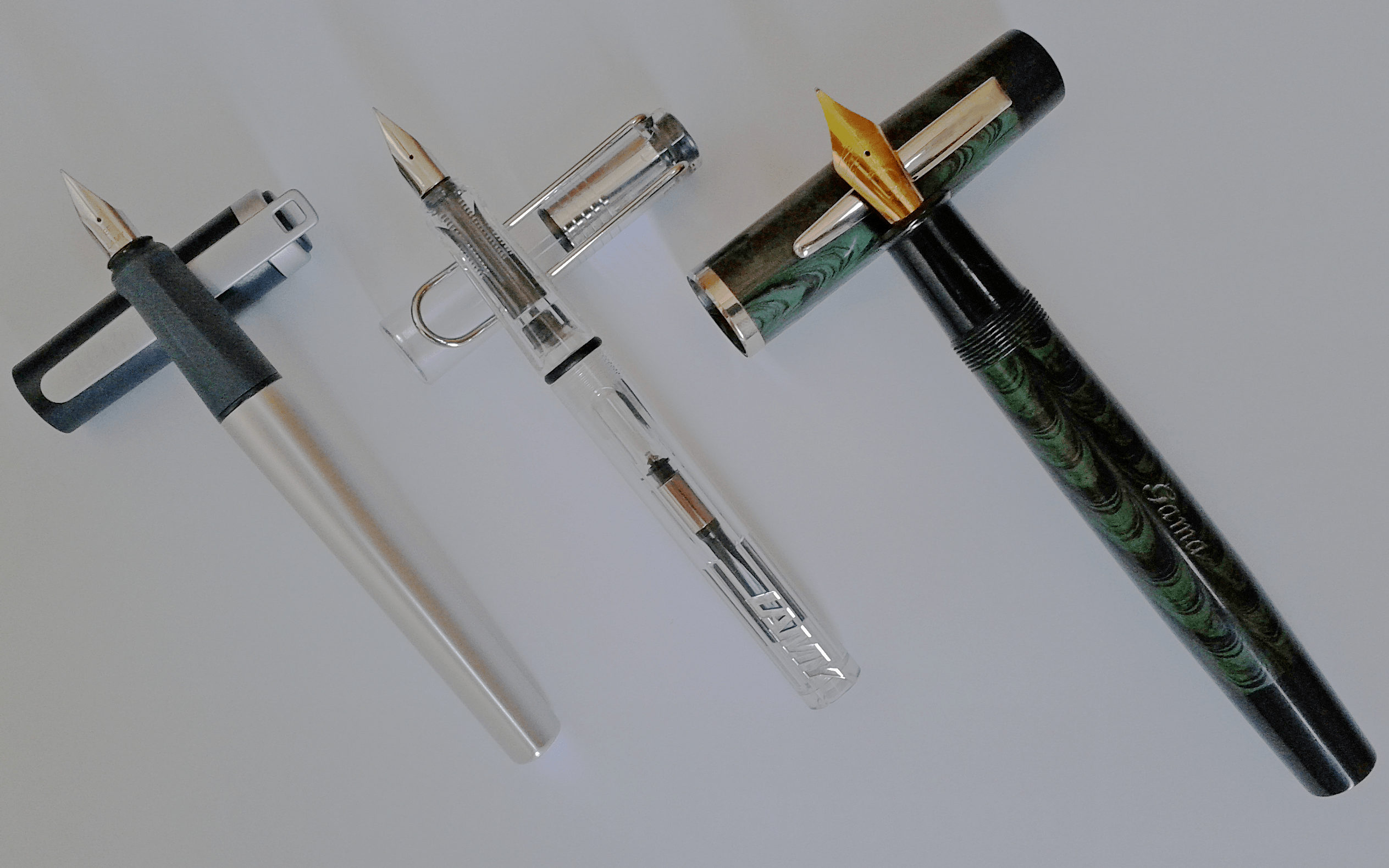
Several fountain pens with various nibs, courtesy of Francis Flinch
Writers new to the fountain pen may notice that their handwriting looks awkward in the beginning; with practice, you will quickly adapt to the differences of using a fountain pen compared to a ballpoint pen. After a few uses, you will grow accustomed to the fountain pen’s heavier weight and the decreased amount of pressure needed to write. With continued practice, you can create thicker lines by changing the nib’s angle to the paper and increasing your writing speed.
Why Use a Fountain Pen?
Investing in a fountain pen will allow you to write more comfortably for longer periods of time. If you are focused on improving your penmanship, a dying art in today’s society, then fountain pens are a great tool. Fountain pens provide more room for personal expression than ballpoint pens. Writing with a fountain pen can make a hand-written letter to a friend or loved one much more meaningful. Many artists and writers prefer working with fountain pens for journaling and drawing because the ease of the ink flow creates more controlled lines. The pen’s versatile nature makes it ideal for any written or artistic statement.
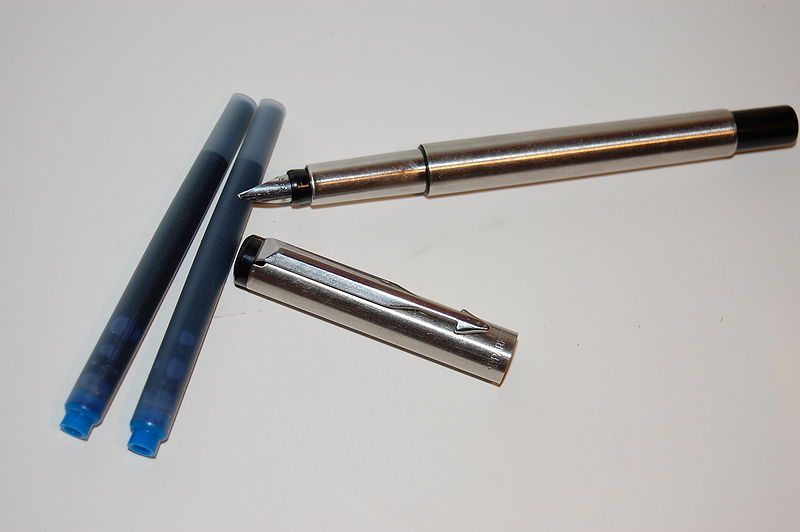
A photograph of disposable ink reservoirs that refill modern fountain pens, available here
If you are environmentally conscious, using a fountain pen creates considerably less plastic waste than ballpoint pens. Fountain pen barrels come in a variety of materials, including metal and wood. The nibs are manufactured with metals such as stainless steel and gold. Only the plastic ink reservoir needs to be replaced, as opposed to throwing away the entire unit of a disposable ballpoint pen. Fountain pen ink cartridges can be reused multiple times as long as they are properly cleaned before refilling with bottled ink. Rinsing the empty cartridge with water and a syringe will remove any excess ink. Replacing your plastic ink reservoir with a refillable converter and using liquid bottled ink can further decrease the amount of discarded plastics.
Fountain Pens: Pros and Cons
Pros
Cons
What is a Ballpoint Pen?
The ballpoint pen is an inexpensive and disposable writing utensil that uses pressure and gravity to transfer a fast-drying and smudge proof oil-based ink from an internal cartridge. At the tip of the pen, a metal ball in a socket remains in constant contact with the ink in the cartridge by the force of gravity. Applying pressure when writing turns the ball, exposing the side of it covered with ink to the writing surface. This technology guarantees that ink is always available from the cartridge without drying out.
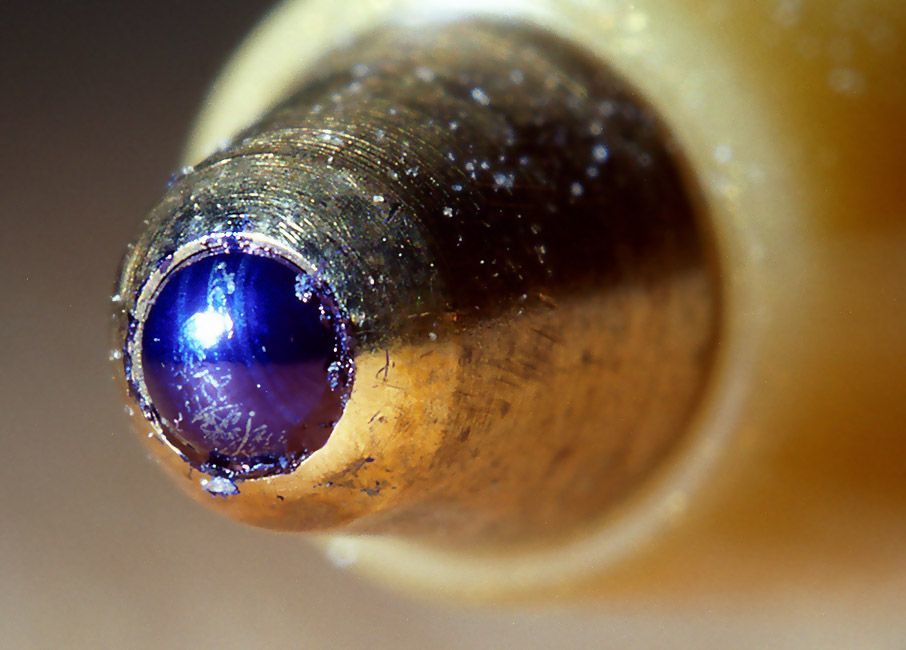
Magnified tip of a ballpoint pen, courtesy of Samsara
Invented to replace quill and fountain pens, ballpoint pens are now the most popular pen on the market. The key to the ballpoint pen’s popularity is that it writes a steady, even line on the page, and the ink is more versatile, able to work on multiple surfaces.
In the 1880s, John J. Loud, an attorney, inventor, and leather tanner, created the ballpoint pen to use on his handiwork. Loud’s design was meant to create a writing utensil that would work on a variety of different surfaces. His invention wrote on leather products, but the tip was too rough to write on paper. Loud’s design resolved his original dilemma, but it was not widely successful because it did not appeal to a large customer base.
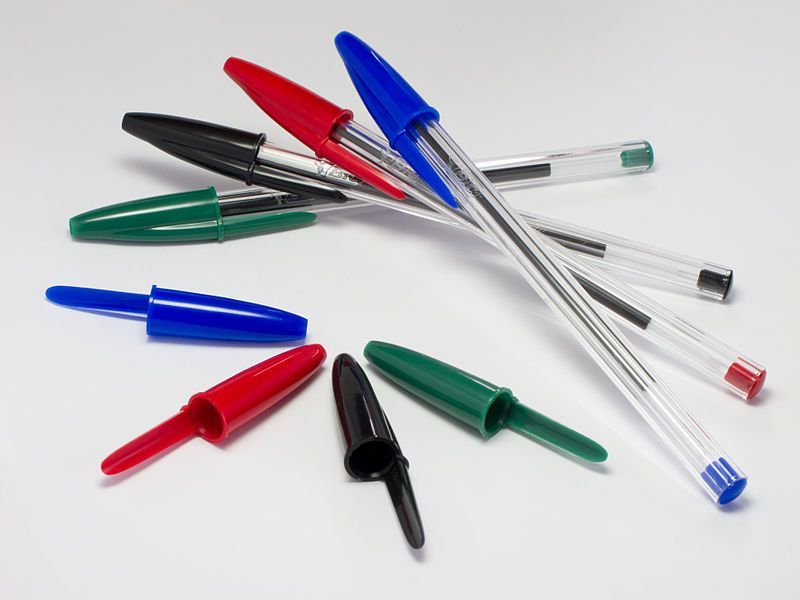
Bic pens are the most popular brand of ballpoint pen. Image courtesy of Carlos Delgado; CC-BY-SA
In 1938, László Bíró, a Hungarian newspaper editor frustrated with the shortcomings of fountain pens, created a ballpoint pen similar to John Loud’s invention. He initially experimented by filling his fountain pen with fast-drying ink used to print newspapers, but the ink was too thick to pass through the nib. Bíró worked with his brother György to create a design that used a rolling metal ball to transfer ink from a cartridge to paper.
The Bíró brothers patented their new ballpoint pen in 1938, but they moved to Argentina in 1943 to escape the Nazis. British World War II pilots discovered that the ballpoint pen wrote better than fountain pens when they were flying, so the Bíró brothers negotiated with the Royal Air Force to produce the ballpoint pen for their pilots.
Bíró’s ballpoint pen became hugely successful for its use in everyday writing. Marcel Bich, a French manufacturer who was born in Italy, bought the patent from the Bíró brothers in 1945, making the ballpoint pen the main product of his newly established company Bic. The company is still in business today as the most recognizable manufacturer of ballpoint pens.
After the end of World War II, Bic and other companies made the ballpoint pen commercially available through mass production. Today, ballpoint pens are ubiquitous and available everywhere. Ballpoints are used starting in grade school all the way through a professional career. They are convenient writing utensils for use on-the-go, and they are easier and less expensive to replace than fountain pens. You can purchase an entire pack of disposable ballpoint pens in almost any store for only a few dollars.
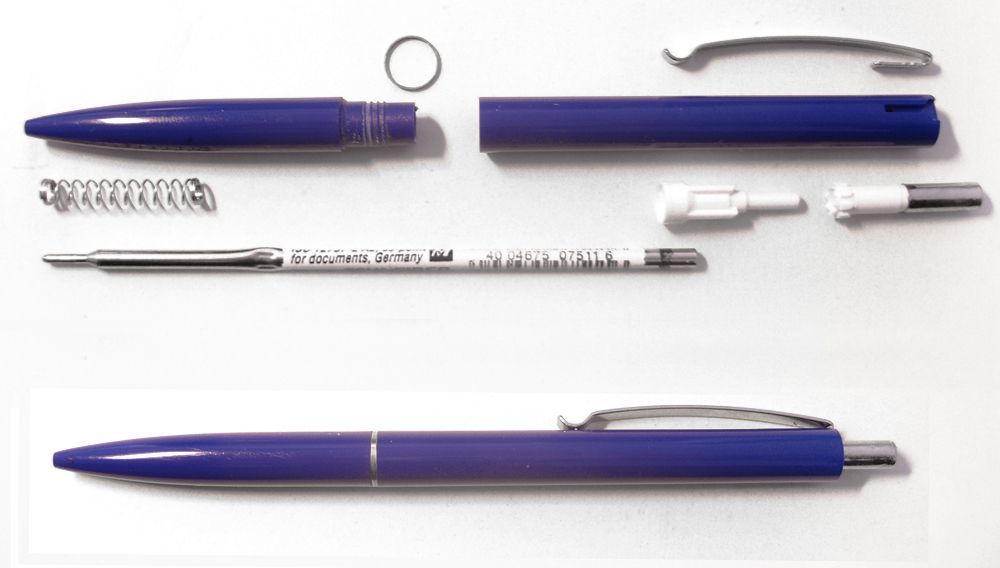
Parts of a Ballpoint Pen, image courtesy of Pavel Krok
Environmental Impact

A landfill in Dryden, Ontario, Canada. Photographed by Michelle Arseneault
The convenience of the disposable ballpoint pen makes it a valuable tool, but it also has negative effects on the environment. Ballpoint pen manufacturers use two types of plastic: polystyrene and polypropylene. Production of polystyrene creates chlorofluorocarbons, which are noxious gases that contribute to global warming over 1,000 times more than carbon dioxide.
The EPA estimates that 1.6 billion disposable pens end up in American landfills every year, which is enough pens to wrap around the Earth almost four hundred times. This is not counting the volumes of waste produced in other more populated countries, like China and India. Refilling ballpoint pens is not a commonly known practice, and many consumers discard the whole pen when the ink runs out. Plastic does not naturally degrade for thousands of years, so ballpoint pens create a constant source of non-biodegradable waste.
The metal ball at the tip of ballpoint pens contain copper, and the adverse environmental effects of copper mining are well-known. Copper mining leads to acidic runoff that can contaminate soil and water sources. The ecological hazards of ballpoint pen production have come to the attention of the EPA and several manufacturers, with each taking steps to prevent the waste of disposable ballpoint pens.
Reduce Ballpoint pen Waste: Donate or Recycle
Recycling companies have also established initiatives to prevent plastics from ending up in landfills. Terracycle, a company based in New Jersey, created a way for homes and businesses to recycle almost every type of waste, including used ballpoint pens, caps, and other plastic writing utensils. The company takes donations and separates them to melt down metals and plastics to create new products.
You can find more information about donating your disposable ballpoint pens here.
Terracycle also has a DIY page with project ideas on how to recycle products that you would throw away, with descriptions on how to make accessories such as jewelry and handbags as well as home and garden décor.
If you are feeling artistically inspired, you can discover ways to “upcycle” your waste into utility and decorative items here.
In 2005, Costas Schuler, a California-based artist and welder, also known as “the Pen Guy,” covered a car with decorations using pens, naming it the “Mercedes Pens.” Since then, he continues to collect ballpoint pens and other hard-to-recycle materials to create beautiful works of art. You can find more information on how to donate your used pens and purchase his recycled art here.
Ballpoint pen owners and users can save the environment by recycling their pens. The manufacturer’s website will detail whether or not the ballpoint pens you use are refillable. Purchasing replaceable ink cartridges for your ballpoint pens is cost-effective and significantly reduces the number of plastics thrown away on a daily basis.
Many pen manufacturers, such as Bic and Papermate, now distribute pens made of recycled materials. A green logo, the Mobius Loop, indicates the percentage of recycled elements included in the product. Several manufacturers will also mark their products as made from recycled materials on their labels.
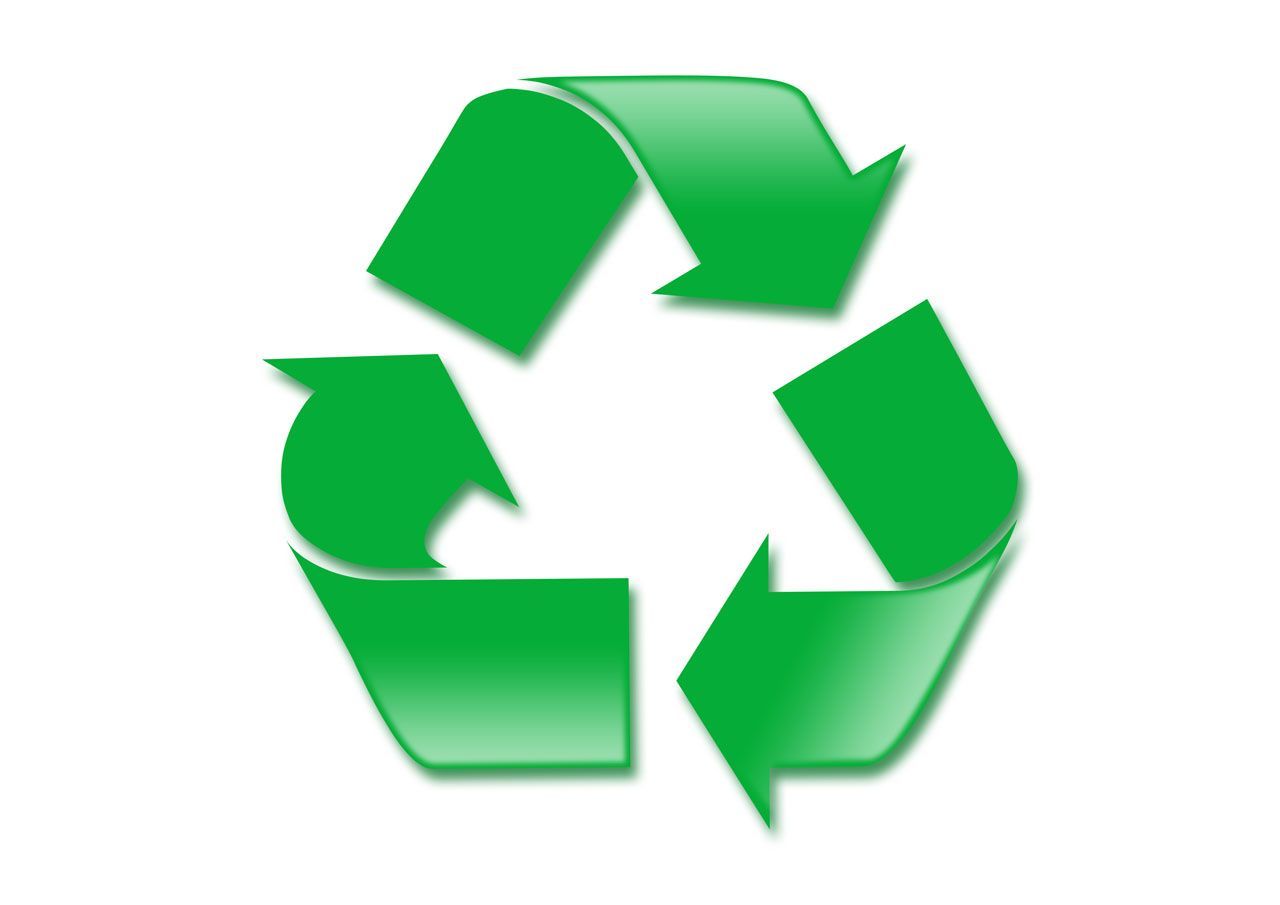
A picture of a Mobius Loop
How to Recycle Ballpoint Pens
Many consumers do not recycle the tubes of ballpoint pens which contain the plastic polypropylene, which can be melted down for reuse in other products. The ink cartridges of refillable ballpoint pens also contain reusable elements. If you do plan on discarding your empty ballpoint pen, or the pen you are using is not refillable, disassemble the pen by separating the plastic barrel and cap from the metal ball, ink cartridge, and spring (if it is a click or twist pen) and recycle the parts according to their material. When ballpoint pens are thrown away intact, they cannot be recycled because the metal and plastic components are not separated.
If you have an overwhelming collection of ballpoint pens that still work but you don’t know what to do with them, you can always donate them. Teachers, nonprofit organizations, and small local businesses buy their supplies on limited budgets, including ballpoint pens, and gifting them your unused or gently used pens will reduce your clutter and help the environment by making sure they are used before they are discarded.
Some classrooms in Africa are extremely limited in supplies. You can donate your ballpoint pens to two non-profits, Develop Africa and Pens for Kids, to help children in Africa have the basic supplies they need to continue their education.
To donate to Develop Africa, click here.
To donate to Pens for Kids, click here.
How to Use a Ballpoint Pen
Ballpoint pens are extremely popular because they are incredibly simple to use. Initially, ballpoint pens had caps to cover the tip, and many manufacturers still sell this design. When writing, remove the cap and place the tip on your writing surface. Applying pressure rotates the metal ball in the socket and distributes the ink.
Technology has advanced to make using the ballpoint pen even easier. Newer designs offer spring-loaded action which reveals or hides the ballpoint tip. This can be done by clicking the push button at the top of the pen or twisting the barrel. With frequent use, a mixture of ink and paper fibers may lead to a gooey substance on the tip of the ballpoint pen, but this is easy to clean by wiping it with a moist cloth or paper towel.
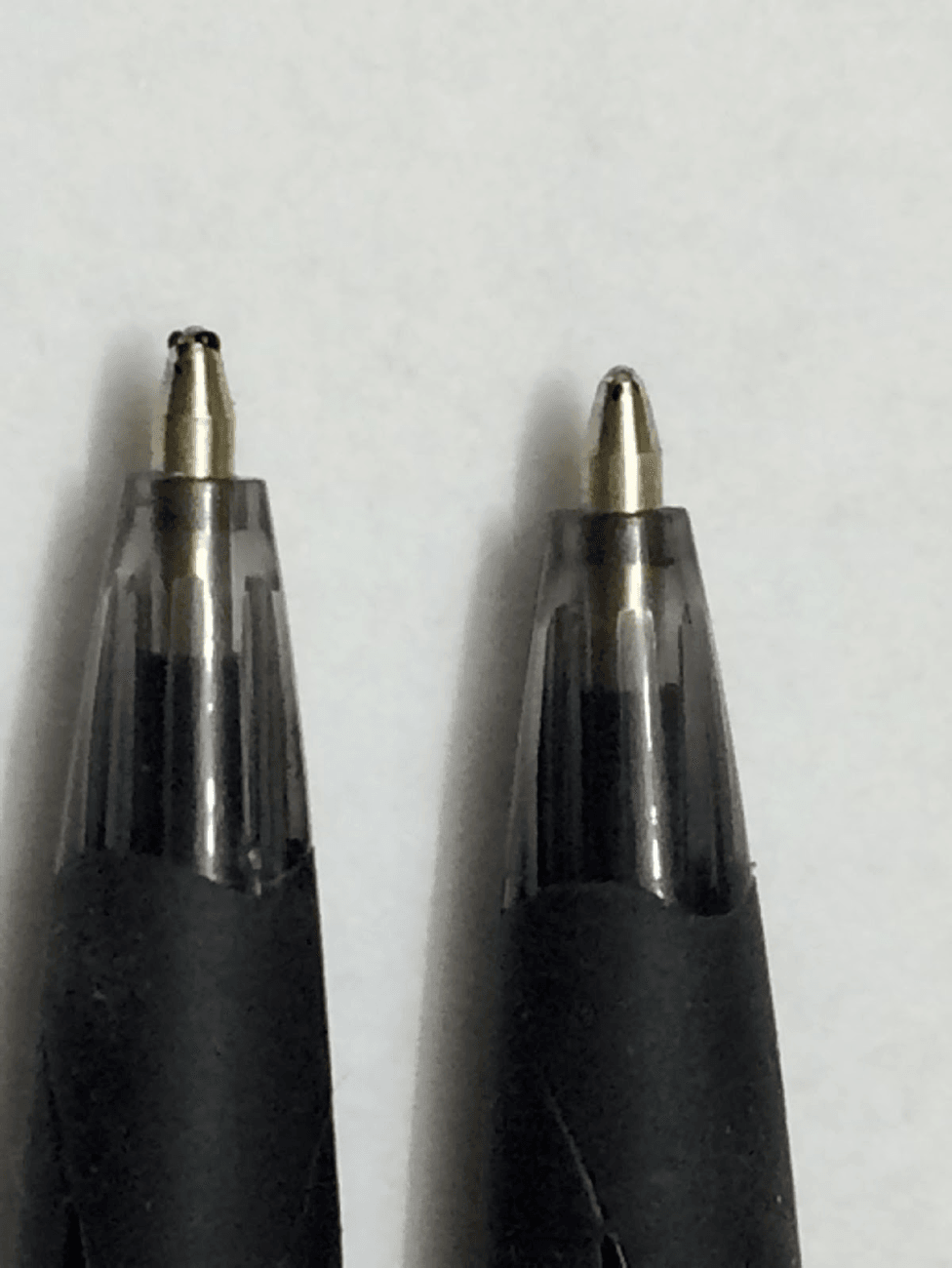
A comparison picture of the Bic Atlantis. The pen on the right is clean, and the pen on the left has a residue on the ballpoint tip resulting from a combination of oil-based ink and paper fibers. (Photograph courtesy of the author.)
Carpal Tunnel Syndrome
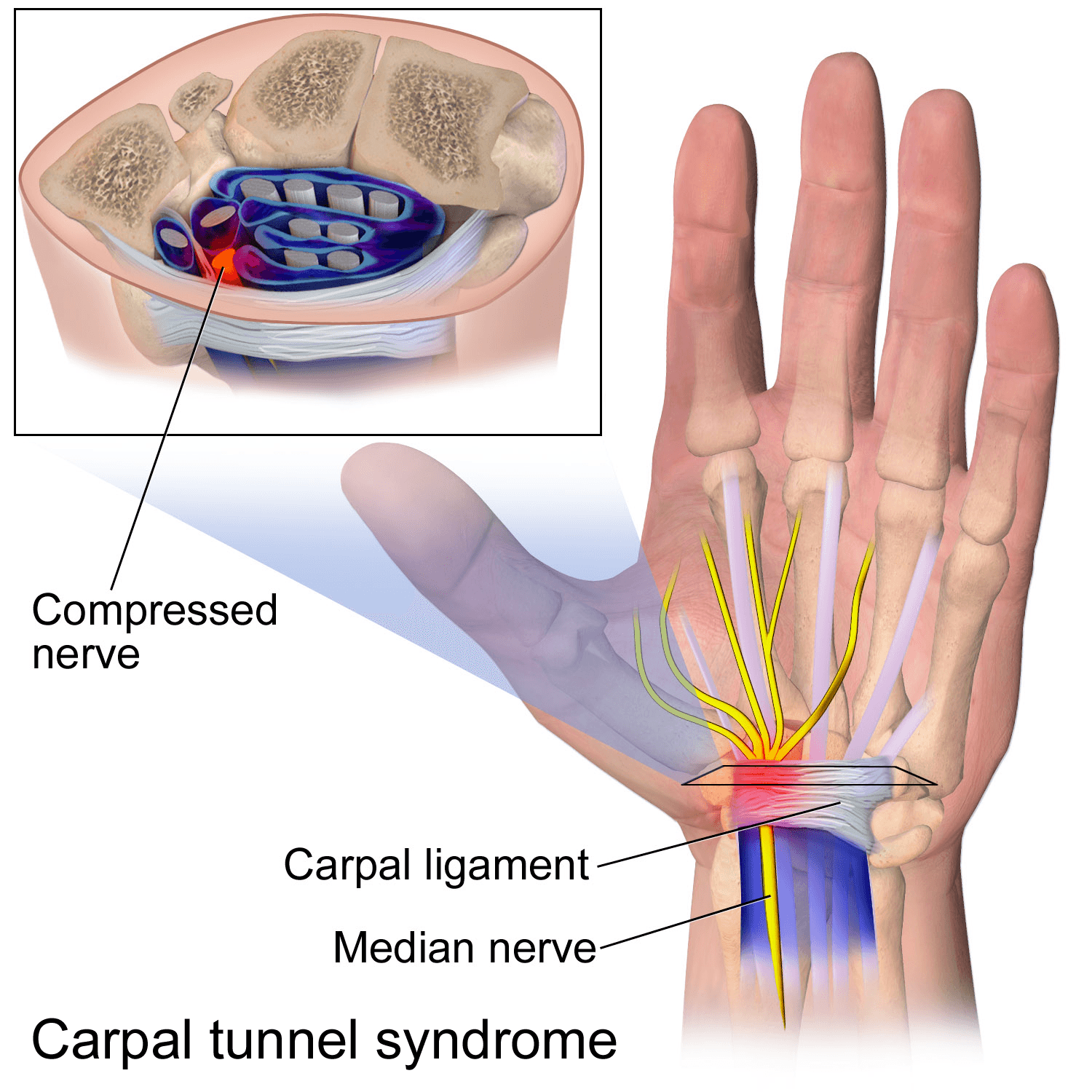
Illustration of Carpal Tunnel Syndrome, which can be caused by the pressure required to use a ballpoint pen. Available through Blausen.com staff (2014). "Medical gallery of Blausen Medical 2014". WikiJournal of Medicine 1 (2). DOI:10.15347/wjm/2014.010. ISSN 2002-4436.
When using a ballpoint pen, you have to apply significantly more pressure from your hand than you would with a fountain pen. This is to make the ink flow around the ballpoint tip. The amount of force required depends on the brand and the manufacturer. Writing with a ballpoint pen for long periods of time leads to ballpoint pen tenosynovitis, also known as “writer’s cramp,” which can contribute to Carpal Tunnel Syndrome, a painful condition that requires medical treatment and can lead to surgery.
With repetitive or awkward movements of the wrist and pressure on the palms, conditions created by prolonged writing with a ballpoint pen, stress can pinch the median nerve in the wrist, causing pain and numbness in the fingers. Doctors discourage patients diagnosed with Carpal Tunnel Syndrome from activities that put any weight on the palm and from gripping narrow items, like using a ballpoint pen.
Why Use a Ballpoint Pen?
Despite the negative effects of ballpoint pens on the environment and the wear on our hands, ballpoint pens are still more convenient than fountain pens. Artists like using ballpoint pens because they can create art using most any canvas or medium. Working professionals use them in all aspects of their lives, such as note-taking, contract signings, and signatures. Students also use ballpoint pens to take notes, written tests, and exams.
Pros
Cons
Are Fountain Pens Better than Ballpoint?
The answer to this question is going to depend on your personal writing style and habits. Each pen has its advantages and its disadvantages and selecting the right pen depends on which characteristics are the most important to you.
If you are a leisurely writer, one who sits at a desk and enjoys the visual aesthetics of writing, then a fountain pen would be a good investment. With digital forms of communication such as text messaging and email, writing a letter or sending a card with a handwritten note inside is taken for granted. If you have a passion for handwritten letters, invitations, or greeting cards, a fountain pen may well improve their overall appearance, especially if you're fond of calligraphy art. The visual aspect of fountain pens themselves also adds an appeal that ballpoint pens do not provide. Fountain pens produce less waste; therefore, they are better for the environment.
If you are looking for convenience, then ballpoint pens are usually the better choice. They are ideal for people with a busy lifestyle, who continuously write notes or need a reliable writing utensil. Unfortunately, this convenience comes at a cost: disposable ballpoint pens create more waste, and the manufacturing process harms the environment.
I have recently become a convert to the fountain pen, even though I have used ballpoint pens for my entire life. As a writer, I spend a significant amount of time taking notes, brainstorming, and making general lists. For years, I believed that writer’s cramp was something that I could not avoid in my profession because I wasn’t familiar with another option. But I now can relive the joy of writing without having to worry about personal health simply by switching to a fountain pen.
As someone who genuinely loves to write, there is creativity to fountain pen writing that I don’t get with a ballpoint pen. The effortless glide of my fountain pen across my paper allows me to be more productive. I can write for hours without having to stop to soothe my cramping hand. Now that I use my fountain pen more, I have noticed less pain and stiffness in my fingers. I am currently taking steps to recycle and re-home my vast collection of ballpoint pens. While I am not abandoning the ballpoint pen, understanding the effects of my lifetime use of them has made me more conscious of the damage they present to the environment and the condition of my hands.
Please comment and share below
Please also share the article with fountain pen or ballpoint pen enthusiasts. We appreciate you spreading the word!
Although this article is comprehensive, the information presented is only as accurate the material we were able to source, and is by no means exhaustive, authoritative, nor complete. If you have additions or corrections which you believe should be included in this page, we invite you to include your comments below. Please consider sharing both the citation as well as the new information with us. Our goal is to foster an open dialogue with our readers.

